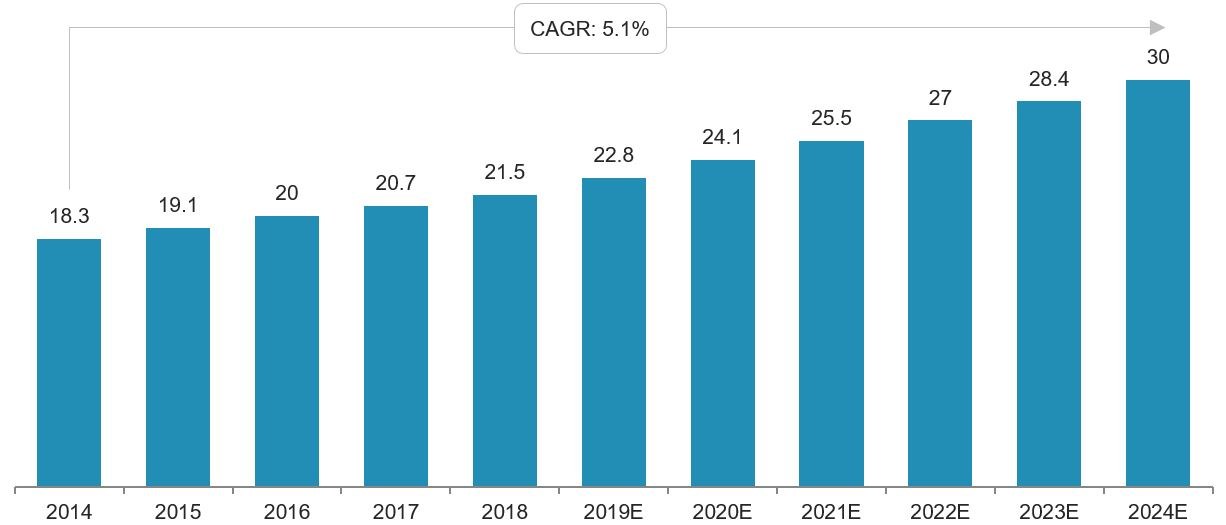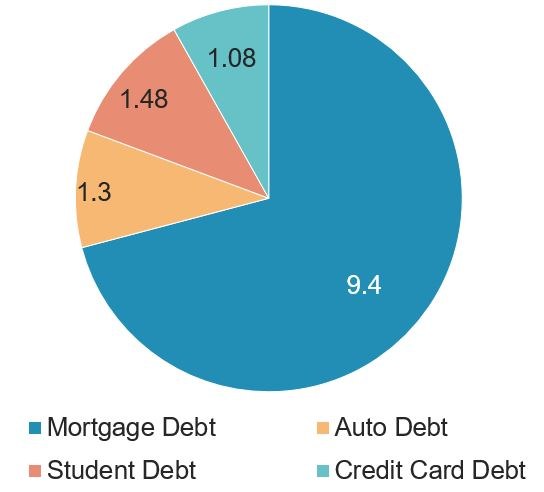Debt Settlement Industry in US
Published on 18 Mar, 2020

The American dream has always attracted people from across the globe. But sadly, today this lustrous dream is losing its sheen due to the growing debt crisis the country is grappling with. Those classy chip-embedded cards or credit cards, as they are known, have proved to be a boon for some while a bane for the others. Total consumer debt, comprising credit cards, mortgage, student loans, and auto loans, in the US climbed to $13.2bn as of Q2 2019. How is the country and its citizens going to escape the enormous debt they have hanging over them?
Debt Scenario in US
The national debt of the US, or any other nation, is the amount that the government owes to its creditors. The diagram below depicts the state of national debt in the US from 2014 onward and the estimate between 2019E and 2024E. As of 2015, the US economy had been suffering from a trade deficit for over a decade, represented by higher imports than exports during those years.
US National Debt ($ trillion)

Source - Statista
The scenario of consumer debt is equally appalling. Total consumer debt climbed to $13.26 trillion as of Q2 2019. This debt is further divided into home, auto, student, and credit card debt.
Four main areas of personal debt ($ trillion) as of Q2 2019:
Personal Debt in US as of Q2 2019
|
Source – Debt.org
Credit Card Debt
In Q3 2019, credit card loans crossed the $1 trillion mark, reaching an all-time high of $1.08 trillion. This is technically a revolving debt as it can be used repeatedly if the credit limit is adhered to and payments are made on time.
Number of borrowers by loan type (in million)

Source – Wallethub, Debt.org
The burgeoning debt of the American citizens can be attributed to their incessant and unnecessary spending patterns. Even though the country was at the top of the GDP game in 2016, it continues to get sucked into the debt trap.
Some credit card trends as of Q2 2019:

Source – Debt.org
This situation of limitless and haphazard spending has led to an increasing number of defaulters in this space.
These are the ramifications that generally follow if a person defaults on debt in the US:
- Chapter 7 – Under Chapter 7 of the Bankruptcy Code, non-exempt assets (any property that can be sold by the court) of a person are used to repay the creditors as per the bankruptcy provision. It is different from Chapter 13 of the Bankruptcy Code as there is no paper filing for repayment.
- Chapter 13 – Under Chapter 13 of the Bankruptcy Code, a person can keep the property and pay instalments as per a repayment plan over the next 3–5 years. This usually suits people with a fixed income stream.
Since these outcomes are daunting for any person to bear, some companies provide other solutions or alternatives wherein the person’s assets are not sold by the court and the person can come out of debt as well. These alternatives are mentioned below:
- Debt Settlement – This method of getting debt free is fast and less expensive. The debt repayment terms are negotiated by professionals, and the defaulting party pays only a fraction of the owed amount.
- Debt Consolidation – Under this debt management strategy, multiple debts are consolidated into a single payment. Usually, the borrower ends up paying at a lower interest rate compared to what was being paid earlier on various debts.
- Credit Counselling – Companies forge close relationships with credit card companies on behalf of the customer. They try to lower the interest rate by deliberating with these companies.
Debt Settlement Services
Debt settlement service providers work on behalf of a financially distressed client by negotiating the settlement terms with creditors and assisting the client in relieving debt. Players in this industry position themselves as customer advocates.
Companies operating in the debt settlement industry mainly cater to credit card outstanding and other unsecured debts such as medical bills, repossessions, and certain business debts. Some of the majors in this space are Freedom Debt Relief and National Debt Relief.
The table below gives a glimpse of how the industry has been grown since 2012:
Fee Model | 2012 | 2015 | 2017 | CAGR (%) |
|---|---|---|---|---|
Total Clients Enrolled | 56,000 | 165,000 | 397,000 | 47.9% |
Total Accounts Enrolled | 354,000 | 1,133,000 | 2,904,000 | 52.3% |
Total Debt Enrolled | $1.7bn | $5bn | $12bn | 47.8% |
Source – American Fair Credit Council
The functioning of the debt settlement companies is as follows:
- Debt settlement service providers have access to a database with information and details of individuals on the verge of defaulting on their personal debts.
- They contact the distressed potential customer and share details of their services with them. If they are hired, they begin work on the customer’s behalf.
- They deliberate with creditors and try to negotiate reasonable terms of repayment by lowering the amount to be paid per dollar owed. For example, paying around $0.60 per $1 owed.
- After negotiation, a repayment plan is made, and the customer then proceeds to make monthly payments that are deposited in an escrow account and after a required time period transferred to the creditor(s).
An intriguing feature of this industry is its countercyclical nature; hence, it performs well during periods of economic downturns. The industry also makes revenue in a growing economy as it makes people act irresponsibly and spend more than their capacity, thus making it difficult to repay. This creates a pool of customers for debt settlement companies.
Similarly, during times of a slowdown, such as recession, the number of customers shoots up again because of higher job losses, low salaries, and so on, making people prone to defaulting on existing debts. Hence, the growth of the debt settlement industry is strongly linked to consumer lending.
Two types of models prevalent in the industry: Legal model and Performance model.
The distinction between the two models is given below:
- Under the legal model, a company can charge an upfront fee, meet customers in person, and can have its own lawyers to negotiate with creditors. Moreover, customers do not need to go for hearings in the court of law as it is taken care of by the attorneys.
- Debt settlement companies operating under the performance model cannot charge an upfront fee from customers as they are prohibited by the Federal Trade Commission Rule 2010. However, legal model-based companies are exempted from this rule.
- Under the performance model, a company can charge fee based on performance, which is a percentage of the debt balance. For instance, a person had an outstanding debt of $2,00,000 and the debt settlement company negotiated with the creditor for a total debt repayment of $1,00,000. Now the debt settlement company will charge a fee of (say) 25% on 100,000 (debt balance or the amount to be paid to the creditor).
A Promising Industry
The debt service industry got the required nudge during and after the financial crisis of 2008–10 due to expansion in credit card debt. It is poised for further growth in the coming years, driven by several favorable factors:
- A reduction in personal savings, a mushrooming of debt, an increase in household financial leverage – all point to the expansion of the debt settlement industry, as debts will continue to grow.
- Debt settlement serves as an alternative to bankruptcy, which could taint a person’s image and lead to a public record with a poor credit history.
- These companies are experts in negotiating with creditors when it comes to minimizing the outstanding debt.
- The industry is attracting substantial investments from private players in the US. For instance,
- In December 2013, Vulcan Capital invested around $125 million in Freedom Financial Network.
The industry now has many active major players and may soon have M&As in a bid for consolidation. More investments from other corporates seeking to expand or diversify their operations in the US will also be seen. Since people earn more and spend even more, and because no one wants to taint their image through court hearings and poor public financial records, I think that the debt settlement industry will soon gain popularity with an ever-expanding customer base.
